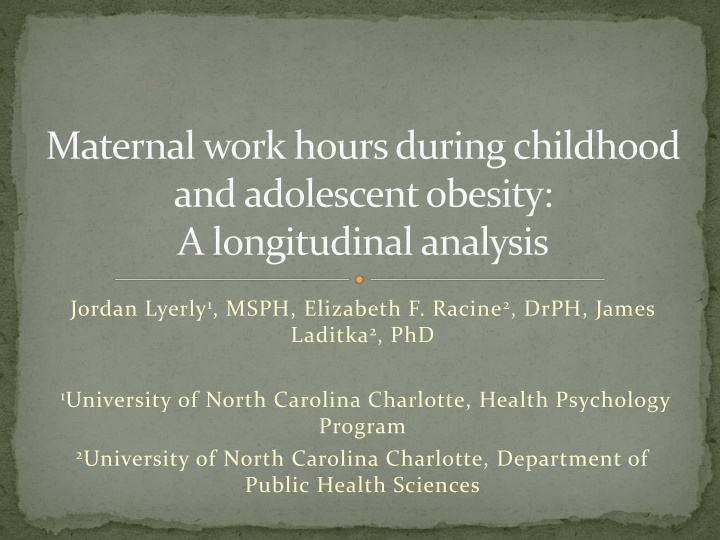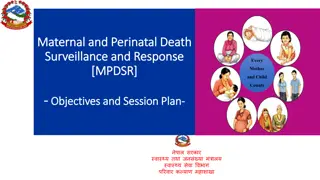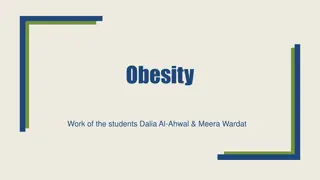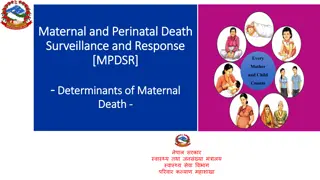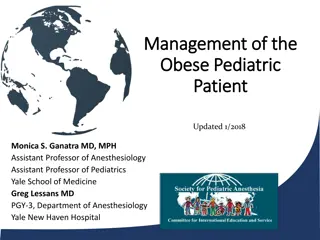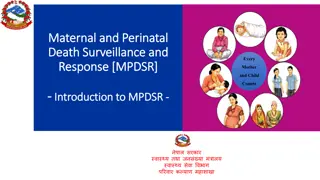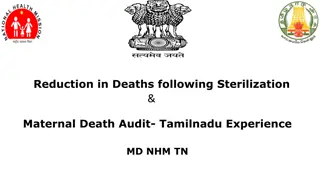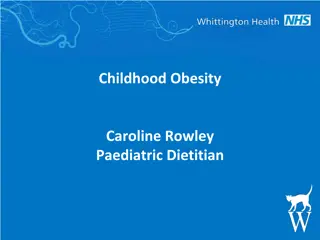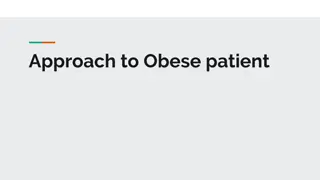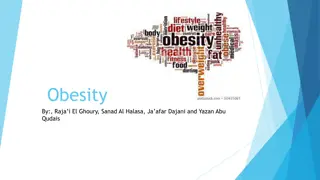Maternal Work Hours and Adolescent Obesity: A Longitudinal Analysis
This study investigates the relationship between increased maternal work hours during childhood and adolescent obesity. It explores how maternal employment and income levels may impact the rates of adolescent obesity, utilizing data from the Panel Survey of Income Dynamics and Child Development Survey. The research questions focus on the association between maternal work hours and adolescent obesity, with consideration for income as a modifying factor. The analysis includes measures of maternal employment, adolescent obesity, and income levels, adjusting for potential covariates. Descriptive results highlight baseline characteristics of participants, including median ages and income distributions, with a notable percentage of adolescents classified as obese in 2007.
Download Presentation

Please find below an Image/Link to download the presentation.
The content on the website is provided AS IS for your information and personal use only. It may not be sold, licensed, or shared on other websites without obtaining consent from the author.If you encounter any issues during the download, it is possible that the publisher has removed the file from their server.
You are allowed to download the files provided on this website for personal or commercial use, subject to the condition that they are used lawfully. All files are the property of their respective owners.
The content on the website is provided AS IS for your information and personal use only. It may not be sold, licensed, or shared on other websites without obtaining consent from the author.
E N D
Presentation Transcript
Maternal work hours during childhood and adolescent obesity: A longitudinal analysis Jordan Lyerly1, MSPH, Elizabeth F. Racine2, DrPH, James Laditka2, PhD 1University of North Carolina Charlotte, Health Psychology Program 2University of North Carolina Charlotte, Department of Public Health Sciences
Background Increase in adolescent obesity rates1and mothers working outside the home2in past 40 years Rationale for relationship Relationship between increased maternal work hours and child and/or adolescent obesity3-8 Limitations of existing research
Research Questions Are increased hours of maternal employment associated with an increased rate of adolescent obesity? How does income modify this relationship?
Methods Design and Participants Data From the Panel Survey of Income Dynamics (1997-2005) and Child Development Survey (1997-2007) Design Longitudinal Participants 1,108 adolescents and their parents
Methods - Measures Exposure Maternal employment during childhood Hours/week worked by mothers over all 3 time points (i.e. during childhood) Outcome Adolescent obesity Weight and height measured by trained staff Considered obese if BMI > 95thpercentile based on sex and age Modifying variable Income Based on the poverty level, considered9: Low income (< 200% of poverty level) Middle income (201%-400% of poverty level) High income (>400% poverty level)
Methods-Analysis Adjusted discrete time series analysis Relative risk 95% confidence intervals Considered several potential covariates Maternal age, maternal education, maternal obesity, marital status, income, child sex, child birth weight, and child physical activity level Interaction between maternal work hours and income
Results: Descriptives At baseline (1996) Median age of child 3.5 yrs Median maternal work hrs/wk 30 Median paternal work hrs/wk 45 Income 42.7% low income 32.0% middle income 25.4% high income In 2007 20.7% of adolescents were obese
Results: Adjusted Relative Risk RR 95% CI Maternal work hrs/wk 1.75 1.01-3.03 Paternal work hrs/wk 1.00 0.61-1.09 Maternal Work Hours by income 0-200% PL vs not 1.45 0.76-2.79 201-400% PL vs. not 2.74 1.15-6.53 401% PL vs. not 2.17 0.53-8.86 No interactive effect of paternal work hours and income on risk of adolescent obesity. Maternal obesity was also associated with an increased risk of adolescent obesity (RR = 2.89, 95% CI=2.16-3.87)
Conclusion As maternal work hours increased, the risk of adolescent obesity increased Income modified this relationship The association between maternal work hours and adolescent obesity was particularly strong among middle income families There was no association between paternal work hours and risk of adolescent obesity
Strengths and limitations Strengths Longitudinal data with detailed information regarding employment and income Measured height and weight Extended research by examining how income modifies the relationship Limitations Attrition Does not address causal mechanism
Implications Better support and services for working mothers to assist in promoting healthy behaviors in children Interventions could address ideas and support for: Quick and healthy meals Healthy eating practices for children Focus groups with mothers from different income levels to understand barriers to healthy eating
References 1. Ogden, C., & Carroll, M. Prevalence of obesity among children and adolescents: United States, trends 1963-1965 through 2007-2008. In: NCHS Health and Stats: National Center for Health Statistics; 2010. 2. US Department of Labor. Women in the laborforce: A databook. http://www.bls.gov/cps/wlf- databook-2012.pdf 3. Anderson, P. M., Butcher, K. F., & Levine, P. B. (2003). Maternal employment and overweight children. Journal of Health Economics, 22, 477-504. 4. Fertig, A., Glomm, G., & Tchernis, R. (2009). The connection between maternal employment and childhood obesity: Inspecting the mechanisms. Review of Economics of the Household, 7, 227-255. 5. Hawkins, S. S., Cole, T. J., & Law, C. (2008). Maternal employment and early childhood overweight: Findings from the UK Millennium Cohort Study. International Journal of Obesity, 32(1), 30-38. 6. Morrissey, T. W. (2012). Trajectories of growth in body mass index across childhood: Associations with maternal and paternal employment. Social Science and Medicine, in press. 7. Von Hinke Kessler Scholder, S. (2008). Maternal employment and overweight children: Does timing matter? Health Economics, 17, 889-906. 8. Ziol-Guest, K. M., Dunifon, R. E., & Kalil, A. (2012). Parental employment and children s body weight: Mothers, others, and mechanisms. Social Science and Medicine, in press. 9. National Center for Health Statistics. Health, United States, 2010: With Special Feature on Death and Dying. Hyattsville, MD. 2011.
